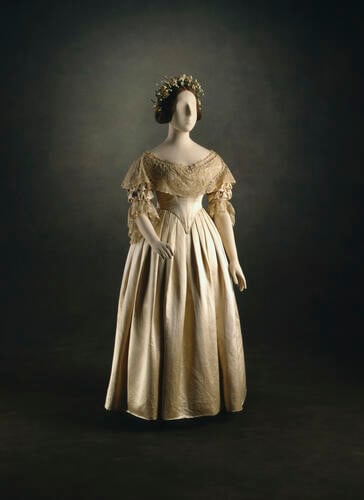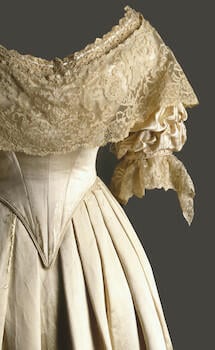-
1 of 253523 objects
Queen Victoria's wedding dress 1840
Cream silk satin with Honiton lace | RCIN 71975
-
Wedding dress ensemble of cream silk satin; comprising pointed boned bodice lined with silk, elbow length gathered sleeves; deep lace flounces at neck and sleeves and plain untrimmed skirt en suite, gathered into waist with unpressed pleats.
Although the fashion at this time was for Brussels lace, Queen Victoria commissioned Honiton lace for her wedding ensemble, reviving the flagging lace industry in Honiton, Devon. This decision may have been made in relation to criticism of the Queen's preference for French textiles, made two years earlier by Lord Melbourne. Partly designed by the Pre-Raphaelite artist William Dyce, the design of the lace was very modern and Queen Victoria was to use the same design numerous times throughout her life. She continued to use it on her own clothes and those of her children and insisted that Honiton lace be used to trim the wedding dresses of her daughters-in-law. This is just one example of an early collaboration between the arts and industry encouraged by Queen Victoria, which eventually resulted in the Great Exhibition of 1851.
Text adapted from Kay Staniland's In Royal Fashion: The Clothes of Princess Charlotte of Wales and Queen Victoria 1796-1901 London 1997Provenance
Queen Victoria's wedding dress was made for her wedding to Prince Albert of Saxe-Coburg-Gotha in 1840. It was probably made by Mary Bettans, her longest serving dressmaker.
-
Medium and techniques
Cream silk satin with Honiton lace


